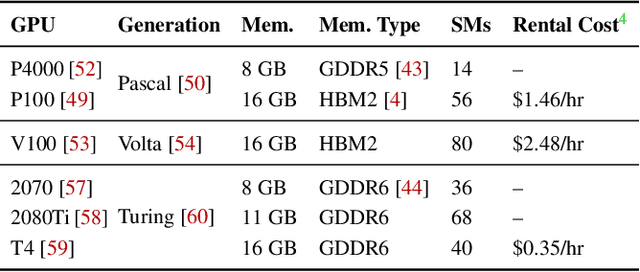Geoffrey X. Yu
Computational Performance Predictions for Deep Neural Network Training: A Runtime-Based Approach
Jan 31, 2021



Abstract:Deep learning researchers and practitioners usually leverage GPUs to help train their deep neural networks (DNNs) faster. However, choosing which GPU to use is challenging both because (i) there are many options, and (ii) users grapple with competing concerns: maximizing compute performance while minimizing costs. In this work, we present a new practical technique to help users make informed and cost-efficient GPU selections: make performance predictions using the help of a GPU that the user already has. Our technique exploits the observation that, because DNN training consists of repetitive compute steps, predicting the execution time of a single iteration is usually enough to characterize the performance of an entire training process. We make predictions by scaling the execution time of each operation in a training iteration from one GPU to another using either (i) wave scaling, a technique based on a GPU's execution model, or (ii) pre-trained multilayer perceptrons. We implement our technique into a Python library called Surfer and find that it makes accurate iteration execution time predictions on ResNet-50, Inception v3, the Transformer, GNMT, and DCGAN across six different GPU architectures. Surfer currently supports PyTorch, is easy to use, and requires only a few lines of code.
Skyline: Interactive In-Editor Computational Performance Profiling for Deep Neural Network Training
Aug 20, 2020



Abstract:Training a state-of-the-art deep neural network (DNN) is a computationally-expensive and time-consuming process, which incentivizes deep learning developers to debug their DNNs for computational performance. However, effectively performing this debugging requires intimate knowledge about the underlying software and hardware systems---something that the typical deep learning developer may not have. To help bridge this gap, we present Skyline: a new interactive tool for DNN training that supports in-editor computational performance profiling, visualization, and debugging. Skyline's key contribution is that it leverages special computational properties of DNN training to provide (i) interactive performance predictions and visualizations, and (ii) directly manipulatable visualizations that, when dragged, mutate the batch size in the code. As an in-editor tool, Skyline allows users to leverage these diagnostic features to debug the performance of their DNNs during development. An exploratory qualitative user study of Skyline produced promising results; all the participants found Skyline to be useful and easy to use.
 Add to Chrome
Add to Chrome Add to Firefox
Add to Firefox Add to Edge
Add to Edge